经济学人11
The Economist 经济学人 常用词汇及解释

The Economist 《经济学人》常用词汇总结我眼泪都流出来了太珍贵了!!来源:商大就协的日志1、绝对优势(Absolute advantage)如果一个国家用一单位资源生产的某种产品比另一个国家多,那么,这个国家在这种产品的生产上与另一国相比就具有绝对优势。
2、逆向选择(Adverse choice)在此状况下,保险公司发现它们的客户中有太大的一部分来自高风险群体。
3、选择成本(Alternative cost)如果以最好的另一种方式使用的某种资源,它所能生产的价值就是选择成本,也可以称之为机会成本。
4、需求的弧弹性(Arc elasticity of demand)如果P1和Q1分别是价格和需求量的初始值,P2 和Q2 为第二组值,那么,弧弹性就等于-(Q1-Q2)(P1+P2)/(P1-P2)(Q1+Q2)5、非对称的信息(Asymmetric information)在某些市场中,每个参与者拥有的信息并不相同。
例如,在旧车市场上,有关旧车质量的信息,卖者通常要比潜在的买者知道得多。
6、平均成本(Average cost)平均成本是总成本除以产量。
也称为平均总成本。
7、平均固定成本( Average fixed cost)平均固定成本是总固定成本除以产量。
8、平均产品(Average product)平均产品是总产量除以投入品的数量。
9、平均可变成本(Average variable cost)平均可变成本是总可变成本除以产量。
10、投资的β(Beta)β度量的是与投资相联的不可分散的风险。
对于一种股票而言,它表示所有现行股票的收益发生变化时,一种股票的收益会如何敏感地变化。
11、债券收益(Bond yield)债券收益是债券所获得的利率。
12、收支平衡图(Break-even chart)收支平衡图表示一种产品所出售的总数量改变时总收益和总成本是如何变化的。
收支平衡点是为避免损失而必须卖出的最小数量。
2021年《经济学人》杂志原版英文(整理完整版)

Digest Of The. Economist. 2006(6-7)欧阳光明(2021.03.07)Hard to digestA wealth of genetic information is to be found in the human gutBACTERIA, like people, can be divided into friend and foe. Inspired by evidence that the friendly sort may help with a range of ailments, many people consume bacteria in the form of yogurts and dietary supplements. Such a smattering of artificial additions, however, represents but a drop in the ocean. There are at least 800 types of bacteria living in the human gut. And research by Steven Gill of the Institute for Genomic Research in Rockville, Maryland, and his colleagues, published in this week's Science, suggests that the collective genome of these organisms is so large that it contains 100 times as many genes as the human genome itself.Dr Gill and his team were able to come to this conclusion by extracting bacterial DNA from the faeces of two volunteers. Because of the complexity of the samples, they were not able to reconstruct the entire genomes of each of the gut bacteria, just the individual genes. But that allowed them to make an estimate of numbers.What all these bacteria are doing is tricky to identify—the bacteria themselves are difficult to cultivate. So the researchers guessed at what they might be up to by comparing the genes they discovered withpublished databases of genes whose functions are already known.This comparison helped Dr Gill identify for the first time the probable enzymatic processes by which bacteria help humans to digest the complex carbohydrates in plants. The bacteria also contain a plentiful supply of genes involved in the synthesis of chemicals essential to human life—including two B vitamins and certain essential amino acids—although the team merely showed that these metabolic pathways exist rather than proving that they are used. Nevertheless, the pathways they found leave humans looking more like ruminants: animals such as goats and sheep that use bacteria to break down otherwise indigestible matter in the plants they eat.The broader conclusion Dr Gill draws is that people are superorganisms whose metabolism represents an amalgamation of human and microbial attributes. The notion of a superorganism has emerged before, as researchers in other fields have come to view humans as having a diverse internal ecosystem. This, suggest some, will be crucial to the success of personalised medicine, as different people will have different responses to drugs, depending on their microbial flora. Accordingly, the next step, says Dr Gill, is to see how microbial populations vary between people of different ages, backgrounds and diets.Another area of research is the process by which these helpful bacteria first colonise the digestive tract. Babies acquire their gut flora asthey pass down the birth canal and take a gene-filled gulp of their mother's vaginal and faecal flora. It might not be the most delicious of first meals, but it could well be an important one.Zapping the bluesThe rebirth of electric-shock treatmentELECTRICITY has long been used to treat medical disorders. As early as the second century AD, Galen, a Greek physician, recommended the use of electric eels for treating headaches and facial pain. In the 1930s Ugo Cerletti and Lucio Bini, two Italian psychiatrists, used electroconvulsive therapy to treat schizophrenia. These days, such rigorous techniques are practised less widely. But researchers are still investigating how a gentler electric therapy appears to treat depression.Vagus-nerve stimulation, to give it its proper name, was originally developed to treat severe epilepsy. It requires a pacemaker-like device to be implanted in a patient's chest and wires from it threaded up to the vagus nerve on the left side of his neck. In the normal course of events, this provides an electrical pulse to the vagus nerve for 30 seconds every five minutes.This treatment does not always work, but in some cases where it failed (the number of epileptic seizures experienced by a patient remaining the same), that patient nevertheless reported feeling much better after receiving the implant. This secondary effect led to trials for treating depression and, in 2005, America's Food and DrugAdministration approved the therapy for depression that fails to respond to all conventional treatments, including drugs and psychotherapy.Not only does the treatment work, but its effects appear to be long lasting. A study led by Charles Conway of Saint Louis University in Missouri, and presented to a recent meeting of the American Psychiatric Association, has found that 70% of patients who are better after one year stay better after two years as well.The technique builds on a procedure called deep-brain stimulation, in which electrodes are implanted deep into the white matter of patients' brains and used to “reboot” f aulty neural circuitry. Such an operation is a big undertaking, requiring a full day of surgery and carrying a risk of the patient suffering a stroke. Only a small number of people have been treated this way. In contrast, the device that stimulates the vagus nerve can be implanted in 45 minutes without a stay in hospital.The trouble is that vagus-nerve stimulation can take a long time to produce its full beneficial effect. According to Dr Conway, scans taken using a technique called positron-emission tomography show significant changes in brain activity starting three months after treatment begins. The changes are similar to the improvements seen in patients who undergo other forms of antidepression treatment. The brain continues to change over the following 21 months. Dr Conway says that patients should be told that the antidepressant effects could be slow in coming.However, Richard Selway of King's College Hospital, London,found that his patients' moods improved just weeks after the implant. Although brain scans are useful in determining the longevity of the treatment, Mr Selway notes that visible changes in the brain do not necessarily correlate perfectly with changes in mood.Nobody knows why stimulating the vagus nerve improves the mood of depressed patients, but Mr Selway has a theory. He believes that the electrical stimulation causes a region in the brain stem called the locus caeruleus (Latin, ironically, for “blue place”) to flood the brain with norepinephrine, a neurotransmitter implicated in alertness, concentration and motivation—that is, the mood states missing in depressed patients. Whatever the mechanism, for the depressed a therapy that is relatively safe and long lasting is rare cause for cheer.The shape of things to comeHow tomorrow's nuclear power stations will differ from today's THE agency in charge of promoting nuclear power in America describes a new generation of reactors that will be “highly economical” with “enhanced safety”, that “minimise wastes” and will prove “proliferation resistant”. No doubt they will bake a mean apple pie, too.Unfortunately, in the world of nuclear energy, fine words are not enough. America got away lightly with its nuclear accident. When the Three Mile Island plant in Pennsylvania overheated in 1979 very little radiation leaked, and there were no injuries. Europe was not so lucky. The accident at Chernobyl in Ukraine in 1986 killed dozens immediatelyand has affected (sometimes fatally) the health of tens of thousands at the least. Even discounting the association of nuclear power with nuclear weaponry, people have good reason to be suspicious of claims that reactors are safe.Yet political interest in nuclear power is reviving across the world, thanks in part to concerns about global warming and energy security. Already, some 441 commercial reactors operate in 31 countries and provide 17% of the planet's electricity, according to America's Department of Energy. Until recently, the talk was of how to retire these reactors gracefully. Now it is of how to extend their lives. In addition, another 32 reactors are being built, mostly in India, China and their neighbours. These new power stations belong to what has been called the third generation of reactors, designs that have been informed by experience and that are considered by their creators to be advanced. But will these new stations really be safer than their predecessors?Clearly, modern designs need to be less accident prone. The most important feature of a safe design is that it “fails safe”. For a re actor, this means that if its control systems stop working it shuts down automatically, safely dissipates the heat produced by the reactions in its core, and stops both the fuel and the radioactive waste produced by nuclear reactions from escaping by keeping them within some sort of containment vessel. Reactors that follow such rules are called “passive”. Most modern designs are passive to some extent and some newer onesare truly so. However, some of the genuinely passive reactors are also likely to be more expensive to run.Nuclear energy is produced by atomic fission. A large atom (usually uranium or plutonium) breaks into two smaller ones, releasing energy and neutrons. The neutrons then trigger further break-ups. And so on. If this “chain reaction” can be controlled, the energy released can be used to boil water, produce steam and drive a turbine that generates electricity. If it runs away, the result is a meltdown and an accident (or, in extreme circumstances, a nuclear explosion—though circumstances are never that extreme in a reactor because the fuel is less fissile than the material in a bomb). In many new designs the neutrons, and thus the chain reaction, are kept under control by passing them through water to slow them down. (Slow neutrons trigger more break ups than fast ones.) This water is exposed to a pressure of about 150 atmospheres—a pressure that means it remains liquid even at high temperatures. When nuclear reactions warm the water, its density drops, and the neutrons passing through it are no longer slowed enough to trigger further reactions. That negative feedback stabilises the reaction rate.Can business be cool?Why a growing number of firms are taking global warming seriously RUPERT MURDOCH is no green activist. But in Pebble Beach later this summer, the annual gathering of executivesof Mr Murdoch's News Corporation—which last year led to a dramatic shift in the mediaconglomerate's attitude tothe internet—will be addressed by several leading environmentalists, including a vice-president turned climatechangemovie star. Last month BSkyB, a British satellite-television company chaired by Mr Murdoch and run by hisson, James, declared itself “carbon-neutral”, having taken various steps to cut or offset its discharges of carboninto the atmosphere.The army of corporate greens is growing fast. Late last year HSBC became the first big bank to announce that itwas carbon-neutral, joining other financial institutions, including Swiss Re, a reinsurer, and Goldman Sachs, aninvestment bank, in waging war on climate-warming gases (of which carbon dioxide is the main culprit). Last yearGeneral Electric (GE), an industrial powerhouse, launched its “Ecomagination” strategy, aiming to cut its output ofgreenhouse gases and to invest heavily in clean (ie, carbon-free) technologies. In October Wal-Mart announced aseries of environmental schemes, including doubling the fuel-efficiency of its fleet of vehicles within a decade.Tesco and Sainsbury, two of Britain's biggest retailers, are competing fiercely to be the greenest. And on June 7thsome leading British bosses lobbied Tony Blair for a more ambitious policy on climate change, even if that involvesharsher regulation.The greening of business is by no means universal, however. Money from Exxon Mobil, Ford and General Motorshelped pay for television advertisements aired recently in America by the CompetitiveEnterprise Institute, with thedaft slogan “Carbon dioxide: they call it pollution; we call it life”. Besides, environmentalist critics say, some firmsare eng aged in superficial “greenwash” to boost the image of essentially climate-hurting businesses. Take BP, themost prominent corporate advocate of action on climate change, with its “Beyond Petroleum” ad campaign, highprofileinvestments in green energy, andev en a “carbon calculator” on its website that helps consumers measuretheir personal “carbon footprint”, or overall emissions of carbon. Yet, critics complain, BP's recent record profits arelargely thanks to sales of huge amounts of carbon-packed oil and gas.On the other hand, some free-market thinkers see the support of firms for regulation of carbon as the latestattempt at “regulatory capture”, by those who stand to profit from new rules. Max Schulz of the ManhattanInstitute, a conservative think tank, not es darkly that “Enron was into pushing the idea of climate change, becauseit was good for its business”.Others argue that climate change has no more place in corporate boardrooms than do discussions of other partisanpolitical issues, such as Darfur or gay marriage. That criticism, at least, is surely wrong. Most of the corporateconverts say they are acting not out of some vague sense of social responsibility, or even personal angst, butbecause climate change creates real business risks and opportunities—from regulatory compliance to insuringclients on flood plains. And although theseconcerns vary hugely from one company to the next, few firms can besure of remaining unaffected.Testing timesResearchers are working on ways to reduce the need for animal experiments, but new laws mayincrease the number of experiments neededIN AN ideal world, people would not perform experiments on animals. For the people, they are expensive. For theanimals, they are stressful and often painful.That ideal world, sadly, is still some way away. People need new drugs and vaccines. They want protection fromthe toxicity of chemicals. The search for basic scientific answers goes on. Indeed, the European Commission isforging ahead with proposals that will increase the number of animal experiments carried out in the EuropeanUnion, by requiring toxicity tests on every chemical approved for use within the union's borders in the past 25years.Already, the commission has identified 140,000 chemicals that have not yet been tested. It wants 30,000 of theseto be examined right away, and plans to spend between €4 billion-8 billion ($5 billion-10 billion) doing so. Thenumber of animals used for toxicity testing in Europe will thus, experts reckon, quintuple from just over 1m a yearto about 5m, unless they are saved by some dramatic advances in non-animal testing technology. At the moment,roughly 10% of European animal tests are forgeneral toxicity, 35% for basic research, 45% for drugs andvaccines, and the remaining 10% a variety of uses such as diagnosing diseases.Animal experimentation will therefore be around for some time yet. But the hunt for substitutes continues, and lastweekend the Middle European Society for Alternative Methods to Animal Testing met in Linz, Austria, to reviewprogress.A good place to start finding alternatives for toxicity tests is the liver—the organ responsible for breaking toxicchemicals down into safer molecules that can then be excreted. Two firms, one large and one small, told themeeting how they were using human liver cells removed incidentally during surgery to test various substances forlong-term toxic effects.PrimeCyte, the small firm, grows its cells in cultures over a few weeks and doses them regularly with the substanceunder investigation. The characteristics of the cells are carefully monitored, to look for changes in theirmicroanatomy.Pfizer, the big firm, also doses its cultures regularly, but rather than studying individual cells in detail, it counts cellnumbers. If the number of cells in a culture changes after a sample is added, that suggests the chemical inquestion is bad for the liver.In principle, these techniques could be applied to any chemical. In practice, drugs (and, in the case of PrimeCyte,food supplements) are top of the list. But that might change if the commission has its way: those 140,000screenings look like a lucrative market, although nobody knowswhether the new tests will be ready for use by2009, when the commission proposes that testing should start.Other tissues, too, can be tested independently of animals. Epithelix, a small firm in Geneva, has developed anartificial version of the liningof the lungs. According to Huang Song, one of Epithelix's researchers, the firm'scultured cells have similar microanatomy to those found in natural lung linings, and respond in the same way tovarious chemical messengers. Dr Huang says that they could be used in long-term toxicity tests of airbornechemicals and could also help identify treatments for lung diseases.The immune system can be mimicked and tested, too. ProBioGen, a company based in Berlin, is developing anartificial human lymph node which, it reckons, could have prevented the near-disastrous consequences of a drugtrial held in Britain three months ago, in which (despite the drug having passed animal tests) six men sufferedmultiple organ failure and nearly died. The drug the men were given made their immune systems hyperactive.Such a response would, the firm's scientists reckon, have been identified by their lymph node, which is made fromcells that provoke the immune system into a response. ProBioGen's lymph node could thus work better than animaltesting.Another way of cutting the number of animal experiments would be tochange the way that vaccines are tested, according to CoenraadHendriksen of the Netherlands Vaccine Institute. At themoment, allbatches of vaccine are subject to the same battery of tests. DrHendriksen argues that this is over-rigorous. When new vaccine culturesare made, belt-and-braces tests obviously need to be applied. But if abatch of vaccine is derived from an existing culture, he suggests that itneed be tested only to make sure it is identical to the batch from which itis derived. That would require fewer test animals.All this suggests that though there is still some way to go before drugs,vaccines and other substances can be tested routinely on cells ratherthan live animals, useful progress is being made. What is harder to see ishow the use of animals might be banished from fundamental research.Anger managementTo one emotion, men are more sensitive than womenMEN are notoriously insensitive to the emotional world around them. At least, that is the stereotype peddled by athousand women's magazines. And a study by two researchers at the University of Melbourne, in Australia,confirms that men are, indeed, less sensitive to emotion than women, with one important and suggestiveexception. Men are acutely sensitive to the anger of other men.Mark Williams and Jason Mattingley, whose study has just been published in Current Biology, looked at the way aperson's sex affects his or her response to emotionally charged facial expressions. People from all cultures agreeon what six basic expressions of emotion look like. Whether the face before you is expressing anger, disgust, fear,joy,sadness or surprise seems to be recognised universally—which suggests that the expressions involved areinnate, rather than learned.Dr Williams and Dr Mattingley showed the participants in their study photographs of these emotional expressions inmixed sets of either four or eight. They asked the participants to look for a particular sort of expression, andmeasured the amount of time it took them to find it. The researchers found, in agreement with previous studies,that both men and women identified angry expressions most quickly. But they also found that anger was morequickly identified on a male face than a female one.Moreover, most participants could find an angry face just as quickly when it was mixed in a group of eightphotographs as when it was part of a group of four. That was in stark contrast to the other five sorts of expression,which took more time to find when they had to be sorted from a larger group. This suggests that something in thebrain is attuned to picking out angry expressions, and that it is especially concerned about angry men. Also, thishighly tuned ability seems more important to males than females, since the two researchers found that men pickedout the angry expressions faster than women did, even though women were usually quicker than men to recognizeevery other sort of facial expression.Dr Williams and Dr Mattingley suspect the reason for this is that being able to spot an angry individual quickly hasa survival advantage—and, since anger is more likely to turn into lethal violence in men than inwomen, the abilityto spot angry males quickly is particularly valuable.As to why men are more sensitive to anger than women, it is presumably because they are far more likely to getkilled by it. Most murders involve men killing other men—even today the context of homicide is usually aspontaneous dispute over status or sex.The ability to spot quickly that an alpha male is in a foul mood would thus have great survival value. It would allowthe sharp-witted time to choose appeasement, defence or possibly even pre-emptive attack. And, if it is right, thisstudy also confirms a lesson learned by generations of bar-room tough guys and schoolyard bullies: if you wantattention, get angry.The shareholders' revoltA turning point in relations between company owners and bosses?SOMETHING strange has been happening this year at company annual meetings in America:shareholders have been voting decisively against the recommendations of managers. Until now, mostshareholders have, like so many sheep, routinely voted in accordance with the advice of the people theyemploy to run the company. This year managers have already been defeated at some 32 companies,including household names such as Boeing, ExxonMobil and General Motors.This shareholders' revolt has focused entirely on one issue: the method by which members of the boardof directors are elected. Shareholder resolutions on other subjects have mostly been defeated, asusual.The successful resolutions called for directors to be elected by majority voting, instead of by thetraditional method of “plurality”—which in practice meant that only votes cast in favour were counted,and that a single vote for a candidate would be enough to get him elected.Several companies, led by Pfizer, a drug giant, saw defeat looming and pre-emptively adopted a formalmajority-voting policy that was weaker than in the shareholder resolution. This required any director whofailed to secure a majority of votes to tender his resignation to the board, which would then be free todecide whether or not to accept it. Under the shareholder resolution, any candidate failing to secure amajority of the votes cast simply would not be elected. Intriguingly, the shareholder resolution wasdefeated at four-fifths of the firms that adopted a Pfizer-style majority voting rule, whereas it succeedednearly nine times out of ten at firms retaining the plurality rule.Unfortunately for shareholders, their victories may prove illusory, as the successful resolutions were all“precatory”—meaning that they merely advised management on the course of action preferred byshareholders, but did not force managers to do anything. Several resolutions that tried to imposemajority voting on firms by changing their bylaws failed this year.Even so, wise managers should voluntarily adopt majority voting, according to Wachtell, Lipton, Rosen &Katz, a Wall Street law firm that has generally helped managers resist increases in shareholder powerbutnow expects majority voting eventually to “become universal”. It advises that, at the very least,managers should adopt the Pfizer model, if only to avoid becoming the subject of even greater scrutinyfrom corporate-governance activists. Some firms might choose to go further, as Dell and Intel have donethis year, and adopt bylaws requiring majority voting.Shareholders may have been radicalised by the success last year of a lobbying effort by managersagainst a proposal from regulators to make it easier for shareholders to put up candidates in boardelections. It remains to be seen if they will be back for more in 2007. Certainly, some of the activistshareholders behind this year's resolutions have big plans. Where new voting rules are in place, they plancampaigns to vote out the chairman of the compensation committee at any firm that they think overpaysthe boss. If the 2006 annual meeting was unpleasant for managers, next year's could be far worse.Intangible opportunitiesCompanies are borrowing against their copyrights, trademarks and patentsNOT long ago, the value of companies resided mostly in things you could see and touch. Today it liesincreasingly in intangible assets such as the McDonald's name, the patent for Viagra and the rights toSpiderman. Baruch Lev, a finance professor at New York University's Stern School of Business, puts theimplied value of intangibles on Americancompanies' balance sheets at about $6 trillion, or two-thirds ofthe total. Much of this consists of intellectual property, the collective name for copyrights, trademarksand patents. Increasingly, companies and their clever bankers are using these assets to raise cash.The method of choice is securitisation, the issuing of bonds based on the various revenues thrown off byintellectual property. Late last month Dunkin' Brands, owner of Dunkin' Donuts, a snack-bar chain, raised$1.7 billion by selling bonds backed by, among other things, the royalties it will receive from itsfranchisees. The three private-equity firms that acquired Dunkin' Brands a few months ago have used thecash to repay the money they borrowed to buy the chain. This is the biggest intellectual-propertysecuritisation by far, says Jordan Yarett of Paul, Weiss, Rifkind, Wharton & Garrison, a law firm that hasworked on many such deals.Securitisations of intellectual property can be based on revenues from copyrights, trademarks (such aslogos) or patents. The best-known copyright deal was the issue in 1997 of $55m-worth of “Bowie Bonds”supported by the future sales of music by David Bowie, a British rock star. Bonds based on the films ofDreamWorks, Marvel comic books and the stories of John Steinbeck have also been sold. As well asDunkin' Brands, several restaurant chains and fashion firms have issued bonds backed by logos andbrands.Intellectual-property deals belong to a class known as operating-asset securitisations. These differ fromstandard securitisations of future revenues, such as bonds backed by the payments on a 30-yearmortgage or a car loan, in that the borrower has to make his asset work. If investors are to recoup theirmoney, the assets being securitised must be “actively exploited”, says Mr Yarett: DreamWorks mustcontinue to churn out box-office hits.The market for such securitisations is still small. Jay Eisbruck, of Moody's, a rating agency, reckons thataround $10 billion-worth of bonds are outs tanding. But there is “big potential,” he says, pointing out thatlicensing patented technology generates $100 billion a year and involves thousands of companies.Raising money this way can make sense not only for clever private-equity firms, but also for companieswith low (or no) credit ratings that cannot easily tap the capital markets or with few tangible assets ascollateral for bank loans. Some universities have joined in, too. Yale built a new medical complex withsome of the roughly $100m it raised securitising patent royalties from Zerit, an anti-HIV drug.It may be harder for investors to decide whether such deals are worth their while. They are, after all,highly complex and riskier than standard securitisations. The most obvious risk is that the investorscannot be sure that the assets will yield what borrowers promise: technology moves on, fashions changeand the demand for sugary snacks may collapse. Valuing intellectual property—an exercise based。
经济学人最新中英对照
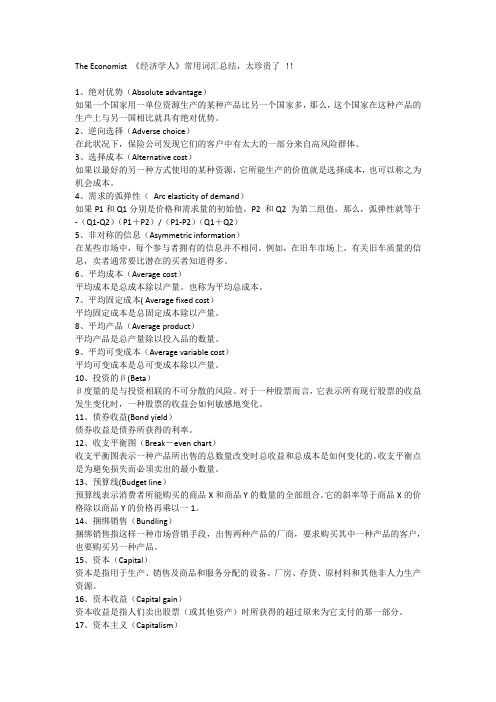
The Economist 《经济学人》常用词汇总结,太珍贵了!!1、绝对优势(Absolute advantage)如果一个国家用一单位资源生产的某种产品比另一个国家多,那么,这个国家在这种产品的生产上与另一国相比就具有绝对优势。
2、逆向选择(Adverse choice)在此状况下,保险公司发现它们的客户中有太大的一部分来自高风险群体。
3、选择成本(Alternative cost)如果以最好的另一种方式使用的某种资源,它所能生产的价值就是选择成本,也可以称之为机会成本。
4、需求的弧弹性(Arc elasticity of demand)如果P1和Q1分别是价格和需求量的初始值,P2 和Q2 为第二组值,那么,弧弹性就等于-(Q1-Q2)(P1+P2)/(P1-P2)(Q1+Q2)5、非对称的信息(Asymmetric information)在某些市场中,每个参与者拥有的信息并不相同。
例如,在旧车市场上,有关旧车质量的信息,卖者通常要比潜在的买者知道得多。
6、平均成本(Average cost)平均成本是总成本除以产量。
也称为平均总成本。
7、平均固定成本( Average fixed cost)平均固定成本是总固定成本除以产量。
8、平均产品(Average product)平均产品是总产量除以投入品的数量。
9、平均可变成本(Average variable cost)平均可变成本是总可变成本除以产量。
10、投资的β(Beta)β度量的是与投资相联的不可分散的风险。
对于一种股票而言,它表示所有现行股票的收益发生变化时,一种股票的收益会如何敏感地变化。
11、债券收益(Bond yield)债券收益是债券所获得的利率。
12、收支平衡图(Break-even chart)收支平衡图表示一种产品所出售的总数量改变时总收益和总成本是如何变化的。
收支平衡点是为避免损失而必须卖出的最小数量。
13、预算线(Budget line)预算线表示消费者所能购买的商品X和商品Y的数量的全部组合。
《经济学人》中英对照
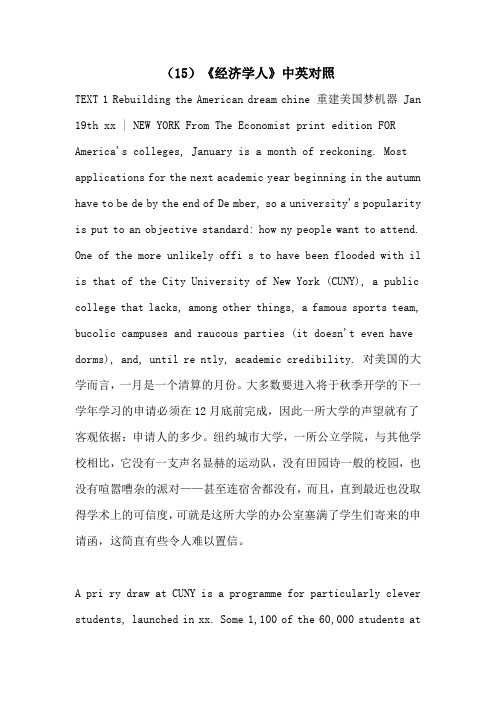
(15)《经济学人》中英对照TEXT 1 Rebuilding the American dream chine 重建美国梦机器 Jan 19th xx | NEW YORK From The Economist print edition FOR America's colleges, January is a month of reckoning. Most applications for the next academic year beginning in the autumn have to be de by the end of De mber, so a university's popularity is put to an objective standard: how ny people want to attend. One of the more unlikely offi s to have been flooded with il is that of the City University of New York (CUNY), a public college that lacks, among other things, a famous sports team, bucolic campuses and raucous parties (it doesn't even have dorms), and, until re ntly, academic credibility. 对美国的大学而言,一月是一个清算的月份。
大多数要进入将于秋季开学的下一学年学习的申请必须在12月底前完成,因此一所大学的声望就有了客观依据:申请人的多少。
纽约城市大学,一所公立学院,与其他学校相比,它没有一支声名显赫的运动队,没有田园诗一般的校园,也没有喧嚣嘈杂的派对——甚至连宿舍都没有,而且,直到最近也没取得学术上的可信度,可就是这所大学的办公室塞满了学生们寄来的申请函,这简直有些令人难以置信。
第11天:经济学人
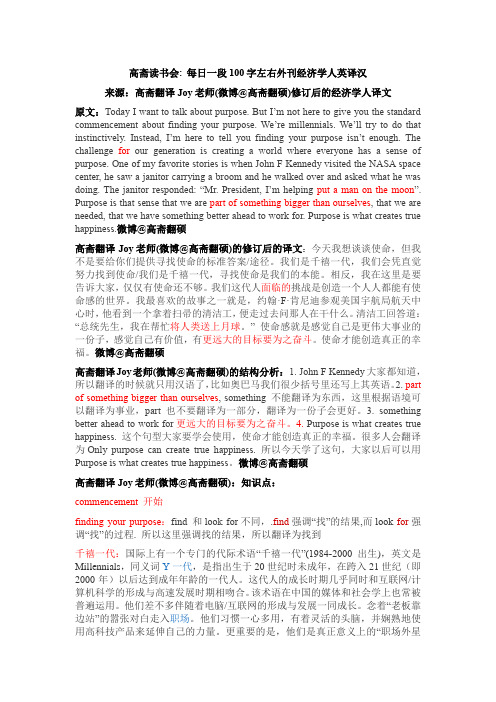
高斋读书会: 每日一段100字左右外刊经济学人英译汉来源:高斋翻译Joy老师(微博@高斋翻硕)修订后的经济学人译文原文:Today I want to talk about purpose. But I’m not here to give you the standard commencement about finding your purpose. We’re millennials. We’ll try to do that instinctively. Instead, I’m here to tell you finding your purpose isn’t enough. The challenge for our generation is creating a world where everyone has a sense of purpose. One of my favorite stories is when John F Kennedy visited the NASA space center, he saw a janitor carrying a broom and he walked over and asked what he was doing. The janitor responded: “Mr. President, I’m helping put a man on the moon”. Purpose is that sense that we are part of something bigger than ourselves, that we are needed, that we have something better ahead to work for. Purpose is what creates true happiness.微博@高斋翻硕高斋翻译Joy老师(微博@高斋翻硕)的修订后的译文:今天我想谈谈使命,但我不是要给你们提供寻找使命的标准答案/途径。
《经济学人》常用词汇
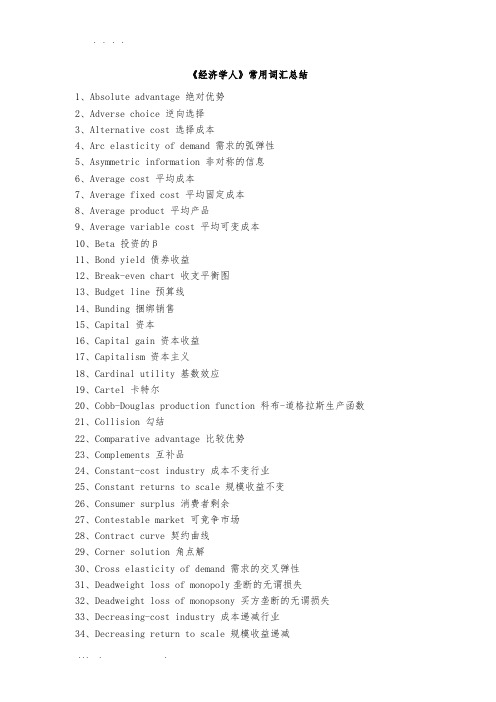
《经济学人》常用词汇总结1、Absolute advantage 绝对优势2、Adverse choice 逆向选择3、Alternative cost 选择成本4、Arc elasticity of demand 需求的弧弹性5、Asymmetric information 非对称的信息6、Average cost 平均成本7、Average fixed cost 平均固定成本8、Average product 平均产品9、Average variable cost 平均可变成本10、Beta 投资的β11、Bond yield 债券收益12、Break-even chart 收支平衡图13、Budget line 预算线14、Bunding 捆绑销售15、Capital 资本16、Capital gain 资本收益17、Capitalism 资本主义18、Cardinal utility 基数效应19、Cartel 卡特尔20、Cobb-Douglas production function 科布-道格拉斯生产函数21、Collision 勾结22、Comparative advantage 比较优势23、Complements 互补品24、Constant-cost industry 成本不变行业25、Constant returns to scale 规模收益不变26、Consumer surplus 消费者剩余27、Contestable market 可竞争市场28、Contract curve 契约曲线29、Corner solution 角点解30、Cross elasticity of demand 需求的交叉弹性31、Deadweight loss of monopoly垄断的无谓损失32、Deadweight loss of monopsony 买方垄断的无谓损失33、Decreasing-cost industry 成本递减行业34、Decreasing return to scale 规模收益递减35、Demand curve 需求曲线36、Demand curve of loanable funds 可贷资金的需求曲线37、Discount rate 贴现率38、Diversifiable risk 可分散风险39、Dominant firm 主导厂商40、Dominant strategy 优势策略41、Duopoly 双头垄断42、Economic efficiency 经济效率43、Economic profit 经济利润44、Economic region of production 生产的经济区域45、Economic resource 经济资源46、Economies of scope 围经济47、Efficient markets hypothesis 有效市场假说48、Endowment position 财富状况49、Engel curve 恩格尔曲线50、Equilibrium 均衡51、Excess capacity 过剩生产能力52、Expansion path 扩路径53、Expected monetary vale期望货币价值54、Expected profit 预期利润55、Expected value of perfect information56、Explicit costs 显成本57、External diseconomy 外部不经济58、External economy 外部经济59、First-mover advantages 先动优势60、Fixed cost 固定成本61、Fixed input 不变投入品62、General equilibrium analysis 一般均衡分析63、Giffen’s paradox 吉芬反论64、Implicit cost 隐成本65、Income-compensated demand curve 收入补偿的需求曲线66、Income-consumption curve 收入-消费曲线67、Income effect 收入效应68、Income elasticity of demand 需求的收入弹性69、Increasing-cost industry成本递增的产业70、Increasing returns to scale 规模收益递增71、Indifference curve 无差异曲线72、Inferior good 劣质商品73、Innovation 创新74、Input 投入品75、Interest rate 利率76、Intermediate good 中间品77、Internal rate of return 部收益率78、Investment 投资79、Investment demand curve 投资需求曲线80、Isocost curve 等成本曲线81、Isoprofit curve 等利润曲线82、Isoquant 等产量曲线83、Isorevenue line 等收益线84、Kinked demand curve 折弯的需求曲线85、Labor 劳动86、Land 土地87、Law of diminishing marginal returns 边际收益递减率88、Lerner index 勒纳指数89、Learning curve 学习曲线90、Limit pricing 限制性定价91、Long run 长期92、Marginal cost 边际成本93、Marginal cost pricing 边际成本定价94、Marginal expenditure curve 边际支出曲线95、Marginal product 边际产品96、Marginal rate of product transformation 边际产品转换率97、Marginal rate of substitution 边际替代率98、Marginal revenue 边际收益99、Marginal revenue product 边际收益产品100、Marginal utility 边际效用101、Market 市场102、Market demand curve 市场需求曲线103、Market period 市场周期104、.Market structure 市场结构105、Market supply schedule 市场供给表106、Markup pricing加成定价107、Maximin strategy 最大最小策略108、Microeconomics 微观经济学109、Minmum efficient size of plant 工厂的最小有效规模110、Model模型111、Money income 货币收入112、Monopolistic competition 垄断竞争113、Monopoly 垄断114、Monopsony 买方垄断115、Moral hazard 道德风险116、Multinational firm 跨国公司117、Multiplant monopoly 多厂垄断118、Multiproduct firm 多产品厂商119、Mutual fund 共同基金120、Nash equilibrium 纳什均衡121、Natural monopoly 自然垄断122、Net-Present-Value Rule 净现值规则123、Nondiversifiable risk 不可分散的风险124、Nonprice competition 非价格竞争125、Normal goods 正常商品126、Oligopoly寡头垄断127、Oligopsony 买方寡头垄断128、Opportunity cost 机会成本129、Optimal input combination 最优投入品组合130、Ordinal utility 序数效用131、Pareto criterion 帕累托标准132、Partial equilibrium analysis 局部均衡分析133、Pecuniary benefits 货币收益134、Perfect Competition 完全竞争135、Perpetuity 不可兑换的公司债券136、Predatory pricing 掠夺性定价137、Present value 现值138、Price ceiling 最高限价139、Pric-consumption curve 价格-消费曲线140、Price discrimination 价格歧视141、Price elastic 富有价格弹性142、Price elasticity of demand 需求的价格弹性143、Price elasticity of supply 供给的价格弹性144、Price floor 最低限价145、Price inelastic缺乏价格弹性146、Price leader 价格领导者147、Price system 价格系统148、Principal-agent problem 委托-代理问题149、Prisoner`s dilemma 囚犯困境150、Private cost 私人成本151、Probability 概率152、Producer surplus 生产者剩余153、Production possibilities curve 生产可能性曲线154、Production function 生产函数156、Profit 利润157、Public good 公共物品158、Quasi-rent 准租金159、Quota 配额160、Ray 射线161、Reaction curve 反应曲线162、Real benefits 真实收益163、Rent 租金164、Ridge lines 脊线165、Risk 风险166、Risk averter 风险厌恶者167、Risk lover 风险爱好者168、Risk neutral 风险中性169、Saving 储蓄170、Second-degree Price discrimination 二级价格歧视171、Selling expenses 销售费用172、Short run 短期173、Social cost 社会成本174、Static efficiency 静态效率175、Strategic move 策略举措176、Substitutes 替代品177、Substitution effect 替代效应178、Supply curve 供给曲线179、Supply curve of loanable funds 可贷资金的供给曲线180、Target return 目标收益181、Tariff 关税182、Technological changes 技术进步183、Technology 技术184、Third-degree price discrimination 三级价格歧视185、Tit for tat 针锋相对186、Total cost 总成本187、Total cost function 总成本函数188、Total cost 总固定成本189、Total revenue 总收益190、Total surplus 总剩余191、Total utility 总效用192、Total variable cost 总可变成本193、Trading possibilities curve 贸易可能性曲线194、Transaction cost 交易成本门195、Transferable emissions permits 可转让的排放许可证196、Two-part tariff 双重收费197、Tying 搭售198、Unitary elasticity 单位弹性199、Utility 效用200、Utility of possibility curve 效用可能性曲线201、Value of marginal product 边际产品价值202、Variable cost 可变成本203、Variable input 可变投入品204、von Neumann-Morgenstern utility function •纽曼--摩根斯坦效用函数204、Winners curse 赢者的诅咒205、Ability-to-pay principle(of taxation)(税收的)支付能力原则206、Absolute advantage(in international trade)(国际贸易中的)绝对优势207、Accelerator principle 加速原理208、Actual,cycical and structual budget 实际预算、周期预算和结构预算209、Adaptive expectations 适用性预期210、Adjustable peg 可调整钉住211、Administered(or inflexible)prices 管理(或非浮动)价格212、Adverse selection 逆向选择213、Aggregate demand 总需求214、Aggregate demand(AD)curve 总需求曲线215、Aggregate supply 总供给216、Aggregate suppy(AS) curve 总供给曲线217、Allocative efficiency 配置效率218、Antitrust legislation 反托拉斯法219、Appreciation(of a currency)(通货)升值220、Appropriable 可分拨221、Arbitrage 套利222、Asset 资产223、Asset demand for money 货币的资产需求224、Automatic(or built-in)stabilizers 自动(或在)稳定器225、Average cost 平均成本226、verage cost curve,long-run( LRAC或 LAC)长期平均成本曲线227、Average cost curve, short-run( SRAC或 SAC)短期平均成本曲线228、Average fixed cost 平均固定成本229、Average product 平均产品230、Average propensity to consume 平均消费倾向231、Average revenue 平均收益232、Average variable cost 平均可变成本233、Balance of international payment 国际收支平衡表234、Balance of trade 贸易余额235、Balance of current account经常项目余额236、Balance sheet 资产负债表237、Balanced budget 平衡预算238、Bank,commercial 商业银行239、Bank money 银行货币240、bank reserves 银行准备会241、进入壁垒Barriers to entry242、Barter 易货贸易243、Benefit principle(of taxation)(税收的)受益原则244、Bond 债券245、Break-even point(in macroeconomics)(宏观经济学中的)收支相抵点246、Bretton woods System 布雷顿森林体系247、Broad money 广义货币248、Budget 预算249、Budget,balanced 平衡预算250、Budget constraint 预算约束251、Budget deficit 预算赤字252、Budget,government 政府预算253、Budget line 预算线254、Budget surplus 预算盈余255、Built-in stabilizers 在稳定器见自动稳定器(automatic stabilizers)256、Business cycles 商业周期257、C+I,C+I+G,or C+I+G+X schedule C+I,C+I+G或 C+I+G+X表258、Capital(capital goods,capital equipment)资本(资本商品,资本设备)259、Capital consumption allowance 资本消耗补偿见折旧(depreciation)260、Capital deepening 资本深化261、Capital gains 资本利得262、Capital markets 资本市场263、Capital-output ratio 资本-产出比率264、Capital widening 资本广化265、Capitalism 资本主义266、Cardinal utility 基数效用267、Cartel 卡特尔268、Central bank 中央银行269、Change in demand vs.change in quantity demanded 需求变化与需求量的变化270、Change in supply vs.supply in quantity 供给变动与供给且的变动271、Checking account(or bank money)支票(或银行货币)272、Chicago School of Economics (经济学)芝加哥学派273、Classical approach 古典理论274、Classical economics 古典经济学275、Classical theories(in macroeconomics)(宏观经济学中的)古典理论276、Clearing market 市场出清277、Closed economy 封闭经济见开放经济(open economy)278、Coase theorem 科斯定理279、Collective bargaining 集体谈判280、Collusion 勾结281、Collusive oligopoly 寡头勾结垄断282、Command economy 指令经济283、Commodity money 商品货币284、Common stock 普通股票285、Communism 共产主义286、Comparative advantage(in international trade)(国际贸易中的)比较优势287、Compensating differentials 补偿性(工资)差异288、Competition,imperfect 不完全竞争289、Competion,perfect 完全竞争290、Competitve equilibrium 竞争均衡291、Competitive market 竞争性市场292、Complements 互补品293、Compound interest 复利294、Concentration ratio 集中度295、Conglomerate 混合联合企业296、Conglomerate merger 混合兼并见兼并(merger)297、Constant returns to scale 规模报酬不变见规模报酬(returns to scale)298、Consumer price index 消费者价格指数(CPI)299、Consumer surplus 消费者剩余300、Consumption 消费301、Consumption function 消费函数302、Consumption-possibility line消费可能线见预算线(budget line)303、Cooperative equilibrium 合作性均衡304、Corporate income tax 公司所得税305、Corporation 公司306、Correlation 相关307、Cost,average 平均成本308、Cost,average fixed 平均固定成本309、Cost,average variable 平均可变成本310、Cost,fixed 固定成本311、Cost,marginal 边际成本312、Cost,minimum 最低成本313、Cost-push inflation 成本推动的通货膨胀314、Cost,total 总成本315、Cost,variable 可变成本316、Crawling(or sliding)peg 爬行(滑动)钉住317、Credit 信贷318、Cross elasticity of demand 需求的交叉弹性319、Crowding-out hypothesis 挤出(效应)假说320、Currency 通货321、Currency appreciation(or depreciation )通货升值(或贬值)322、Current account 经常见贸易余额(balance of trade)323、Cyclical budget 周期预算324、Cyclical unemployment 周期性失业325、Deadweight loss 净损失326、Debit 借方327、Decreasing returns to scale 规模报酬递减328、Deficit spending 赤字性支出329、Deflating(of economic data)(经济数据)紧缩330、Deflation 通货紧缩331、Demand curve(or demand schedule)需求曲线(或需求表)332、Demand for money 货币需求333、Demand-pull inflation 需求拉动型通货膨胀334、Demography 人口学335、Depreciation(of an asset)(资产)折旧336、Depreciation(of a currency)(通货)贬值337、Depression 萧条338、Derived demand 派生需求339、Devaluation 降值340、Developing country 发展中国家见欠发达国家(less developed country)341、Differentiated products 差异产品342、Diminishing marginal utility,law of 边际效用递减规律343、Diminishing returns,law of 收益递减规律344、Direct taxes 直接税345、Discount rate 贴现率346、Discounting(of future income)(未来收人)折现347、Discrimination 歧视348、Disequilibrium 非均衡349、Disinflation 反通货膨胀350、Disposable income 可支配收入(DI)351、Disposable personal income 个人可支配收入352、Dissaving 负储蓄354、Division of labor 劳动分工355、Dominant equilibrium 占优均衡见占优战略(dominant strategy)356、Dominant strategy 占优战略357、Downward-sloping demand,law of 需求向下倾斜规律358、Duopoly 双头垄断359、Duopoly price war 双头垄断价格战360、Easy-money policy 宽松的货币政策361、Econometrics 经济计量学362、Economic goods 经济物品363、Economic growth 经济增长364、Economic reguation 经济管制365、Economic rent 经济租金见"经济租金"(rent, economic)366、Economic surplus 经济剩余367、Economics of information 信息经济学368、Economies of scale 规模经济369、Economies of scope 广度经济370、Effective tax rate 有效税率371、Efficiency 效率372、Efficiency-wage theory 有效工资理论373、Efficient market 有效市场374、Elasticity 弹性375、Employed 就业者参见"失业"(unemployment)376、Equal-cost line 等成本线377、Equal-product curve(or isoquant)等产量线378、Equilibrium 均衡379、Equilibrum(for a business firm)厂商均衡380、Equilibrium(for the individual consumer)单个消费者的均衡381、Equilibrium,competitive 竞争均衡见竟争均衡(competitive equilibrium)382、Equilibrium,general 一般均衡见一般均衡分析(general-equilibrium analysis)383、Equilibrium,macroeconomic 宏观经济均衡384、Equimarginal principle 等边际法则385、Exchange rate 汇率见外汇汇率(foreign exchange rate)386、Exchange-rate system 汇率制度387、Excise tax vs.sales tax 消费税和销售税388、Exclusion principle 排他原则389、Exogenous vs.induced variables 外生变量和引致变量390、Expectations 预期391、Expenditure multiplier 支出乘数参见乘数(multiplier)392、Exports 出口393、External diseconomies 外部不经济394、External economies 外部经济395、External variables 外部变量同外生变量(exogenous variables)396、Externalities 外部性397、Factors of production 生产要素398、Fallacy of composition 合成谬误399、Federal Reserve System 联邦储备系统美国的中央银行(centra bank)400、Fiat money 法定货币没有在价值(intrinsic value)401、Final goods 最终产品402、Financial economics 金融经济学403、Financial intermediary 金融中介404、Firm(business firm)厂商405、Fiscal-monetary mix 财政-货币政策组合406、Fiscal policy 财政政策407、Fiscal cost 固定成本见固定成本(cost,fixed)408、Fixed exchange rate 固定汇率见外汇汇率(foreign exchangs rate)409、Flexible exchange rates 弹性汇率制410、Floating exchange rates 浮动汇率制见弹性汇率制(flexibleexchange rates)411、Flow vs. stock 流量与存量412、Foreign exchange 外汇413、Foreign exchange market 外汇市场414、Foreign exchange rate 外汇汇率415、Fourfirm concentration rate 四企业集中度见集中度(concentration ratio)416、Fractional-reserve banking 部分准备金417、Free goods 免费品不属于经济品(economic goods)418、Free trade 自由贸易419、Frictional unemployment 磨擦性失业420、Full employment 充分就业421、Gains from trade 贸易利得422、Galloping inflation 急剧的通货膨胀见通货膨胀(inflation)423、Game theory 博弈论424、General-equilibrium analysis 一般均衡分析425、GDP deflator GDP紧缩指数426、GDP gap GDP缺口427、GNP 国民生产总值见国民生产总值(gloss national product)428、Gold standard 全本位制429、Government debt 政府债务430、Goverment expenditure multiplier 政府支出乘数431、Graduated income tax 累进所得税见个人所得税(income tax,personal)432、Gresham`s Law 格雷欣法则433、Gross domestic product,nominal(or nominal GDP)名义国生产总值(或名义GDP)434、Gross domestic product,real 实际国生产总值(实际GDP)435、Gross national product,nominal 名义国民生产总值(或名义GNP)436、Gross national product,real 实际国民生产总值(实际GNP)437、Growth accounting 增长核算438、Hedging 套期保值439、High-powered money 高能货币见基础货币(monetary base)440、Horizontal equity vs.vertical equity 横向平等与纵向平等441、Horizontal integration 横向整合见纵向整合与横向整合(integration, vertical vs.horizontal)442、Horizontal merger 横向兼井见兼并(merger)443、Human capital 人力资本444、Hyperinflation 恶性通货膨胀见通货膨胀(inflation)445、Imperfect competition 不完全竞争见不完全竞争(competition,imperfect)446、Imperfect competitor 不完全竞争者447、Implicit-cost elements 隐性成本要素显性货币成本(explicit money costs)448、Imports 进口见出口(exports)449、Inappropriability 不可分拨性见不可分拨(inappropriable)450、Inappropriable 不可分拨451、Incidence(or tax incidence)归宿,或税赋归宿452、Income 收入453、Income effect(of a price change)(价格变动的)收入效应454、Income elasticity of demand 需求的收入弹性455、Income statement 收益表456、Income tax,negative 负所得税见负所得税(egative income tax)457、Income tax,personal 个人所得税458、Income velocity of money 货币的收入周转率459、Incomes policy 收入政策460、Increasing returns to scale 递增的规模报酬见规模报酬(returns to scale)461、Independent goods 独立品462、Indexing(or indexation)指数化463、Indifference curve 无差异曲线464、indifference map 无差异曲线图465、Indirect taxes 间接税见直接税(direct taxes)466、Induced variables 引致变量467、Industry 产业468、Inertial rate of inflation 惯性通货膨胀率469、Infant industry 幼稚产业470、Inferior goods 低档品或劣等品471、Inflation(or inflation rate)通货膨胀(或通货膨胀率)472、Inflation targeting 通货膨胀目标473、Innovation 创新474、Inputs 投入475、Insurance 保险476、Integration,vertical vs.horizontal 纵向整合和横向整合477、Intellectual property rights 知识产权478、Interest 利息479、Interest rate 利率480、Intermediate goods 中间产品481、International monetary system(also International financial system)国际货币制度(国际金融体系)482、Intervention 干预483、Intrinsic value(of money)(货币的)在价值484、Invention 发明485、Investment 投资487、Invisible hand 看不见的手488、Involuntarily unemployed 非自愿失业见失业(unemployment)489、Iron law of wages 工资铁律490、Isoquant 等产量见等产量曲线(equal product curve)491、Keynesian economics 凯恩斯经济学492、Keynesian school 凯恩斯学派见凯恩斯主义经济学(Keynesian economics)493、Labor force 劳动力494、Labor-force participstion rate 劳动力参与率495、Labor productivity 劳动生产率见生产率(productivity)496、Labor supply 劳动供给497、Labor theory of value 劳动价值论498、Laissez-faire("leave us along")自由放任(“别来管我”)499、Land 土地500、Least-cost rule(of production)(生产的)最低成本法则501、Legal tender 法定清偿物502、Less developed country(LDC)欠发达国家503、Liabilities 负债504、Libertarianism 自由放任主义505、Limited Liability 有限责任506、Long run 长期507、Long-run aggregate supply schedule 长期总供给表508、Lorenz curve 洛伦茨曲线509、Lowest sustainable rate of unemployment(or LSUR)最低可持续失业率510、Lump-of-labor fallacy 劳动合成谬误511、M1、 M2参见货币供应(money supply)。
《经济学人》757条常用词汇总结

The Economist《经济学人》757条常用词汇总结1、绝对优势(Absolute advantage )如果一个国家用一单位资源生产的某种产品比另一个国家多,那么,这个国家在这种产品的生产上与另一国相比就具有绝对优势。
2、逆向选择(Adverse choice )在此状况下,保险公司发现它们的客户中有太大的一部分来自高风险群体。
3、选择成本(Alternative cost )如果以最好的另一种方式使用的某种资源,它所能生产的价值就是选择成本,也可以称之为机会成本。
4、需求的弧弹性(Arc elasticity of demand )如果Pl和QI分别是价格和需求量的初始值,P2和Q2为第二组值,那么,弧弹性就等于-(Ql-Q2)( P1+P2)/(P1-P2) (Q1+Q2)5、非对称的信息(Asymmetric information )在某些市场中,每个参与者拥有的信息并不相同。
例如,在旧车市场上,有关旧车质量的信息,卖者通常要比潜在的买者知道得多。
6、平均成本(Average cost )平均成本是总成本除以产量。
也称为平均总成木。
7、平均固定成本(Average fixed cost )平均固定成本是总固定成本除以产量。
8、平均产品(Average product )平均产品是总产量除以投入品的数量。
9、平均可变成本(Average variable cost )平均可变成本是总可变成本除以产量。
10、投资的3 (BetaB度量的是与投资相联的不可分散的风险。
对于一种股票而言,它表示所有现行股票的收益发生变化时,一种股票的收益会如何敏感地变化。
11、债券收益(Bond yield )债券收益是债券所获得的利率。
12、收支平衡图(Break- even chart )收支平衡图表示一种产品所出售的总数量改变时总收益和总成本是如何变化的。
收支平衡点是为避免损失而必须卖出的最小数量。
the_economist经济学家 词汇总结

The Economist《经济学人》常用词汇总结1、绝对优势(Absolute advantage)如果一个国家用一单位资源生产的某种产品比另一个国家多,那么,这个国家在这种产品的生产上与另一国相比就具有绝对优势。
2、逆向选择(Adverse choice)在此状况下,保险公司发现它们的客户中有太大的一部分来自高风险群体。
3、选择成本(Alternative cost)如果以最好的另一种方式使用的某种资源,它所能生产的价值就是选择成本,也可以称之为机会成本。
4、需求的弧弹性(Arc elasticity of demand)如果P1和Q1分别是价格和需求量的初始值,P2和Q2为第二组值,那么,弧弹性就等于-(Q1-Q2)(P1+P2)/(P1-P2)(Q1+Q2)5、非对称的信息(Asymmetric information)在某些市场中,每个参与者拥有的信息并不相同。
例如,在旧车市场上,有关旧车质量的信息,卖者通常要比潜在的买者知道得多。
6、平均成本(Average cost)平均成本是总成本除以产量。
也称为平均总成本。
7、平均固定成本( Average fixed cost)平均固定成本是总固定成本除以产量。
8、平均产品(Average product)平均产品是总产量除以投入品的数量。
9、平均可变成本(Average variable cost)平均可变成本是总可变成本除以产量。
10、投资的β(Beta)β度量的是与投资相联的不可分散的风险。
对于一种股票而言,它表示所有现行股票的收益发生变化时,一种股票的收益会如何敏感地变化。
11、债券收益(Bond yield)债券收益是债券所获得的利率。
12、收支平衡图(Break-even chart)收支平衡图表示一种产品所出售的总数量改变时总收益和总成本是如何变化的。
收支平衡点是为避免损失而必须卖出的最小数量。
13、预算线(Budget line)预算线表示消费者所能购买的商品X和商品Y的数量的全部组合。
经济学人11-18
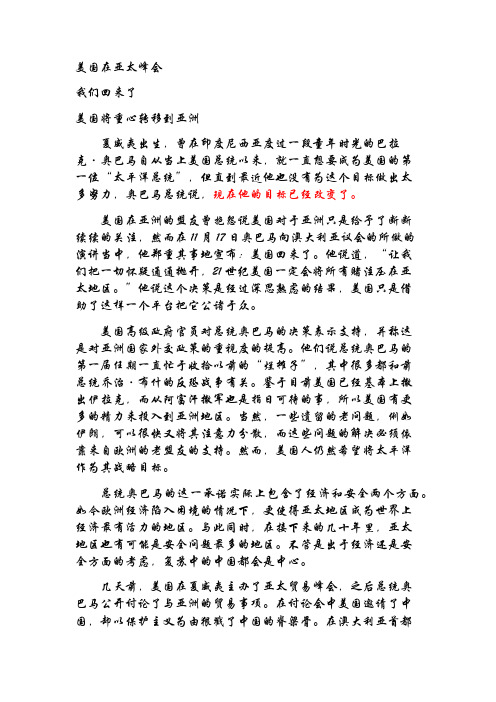
美国在亚太峰会我们回来了美国将重心转移到亚洲夏威夷出生,曾在印度尼西亚度过一段童年时光的巴拉克〃奥巴马自从当上美国总统以来,就一直想要成为美国的第一位“太平洋总统”,但直到最近他也没有为这个目标做出太多努力,奥巴马总统说,现在他的目标已经改变了。
美国在亚洲的盟友曾抱怨说美国对于亚洲只是给予了断断续续的关注,然而在11月17日奥巴马向澳大利亚议会的所做的演讲当中,他郑重其事地宣布:美国回来了。
他说道,“让我们把一切怀疑通通抛开,21世纪美国一定会将所有赌注压在亚太地区。
”他说这个决策是经过深思熟虑的结果,美国只是借助了这样一个平台把它公诸于众。
美国高级政府官员对总统奥巴马的决策表示支持,并称这是对亚洲国家外交政策的重视度的提高。
他们说总统奥巴马的第一届任期一直忙于收拾以前的“烂摊子”,其中很多都和前总统乔治〃布什的反恐战争有关。
鉴于目前美国已经基本上撤出伊拉克,而从阿富汗撤军也是指日可待的事,所以美国有更多的精力来投入到亚洲地区。
当然,一些遗留的老问题,例如伊朗,可以很快又将其注意力分散,而这些问题的解决必须依靠来自欧洲的老盟友的支持。
然而,美国人仍然希望将太平洋作为其战略目标。
总统奥巴马的这一承诺实际上包含了经济和安全两个方面。
如今欧洲经济陷入困境的情况下,更使得亚太地区成为世界上经济最有活力的地区。
与此同时,在接下来的几十年里,亚太地区也有可能是安全问题最多的地区。
不管是出于经济还是安全方面的考虑,复苏中的中国都会是中心。
几天前,美国在夏威夷主办了亚太贸易峰会,之后总统奥巴马公开讨论了与亚洲的贸易事项。
在讨论会中美国邀请了中国,却以保护主义为由狠戳了中国的脊梁骨。
在澳大利亚首都堪培拉,美国总统奥巴马提到了安全问题,并且与澳大利亚总理联合声明美国将会派出舰队与澳大利亚在其北部的达尔文市进行联合军演,明年将派出250支舰队,往后其数字将逐渐增加到2500。
美国寄希望于此次与澳大利亚的合作能够开一个好头,继而加强与亚太地区其他盟友的合作,尤其是与东南亚国家的合作。
The-Economist常用词汇总结及经济学原理

The Economist《经济学人》常用词汇总结(全集)1、绝对优势(Absolute advantage)如果一个国家用一单位资源生产的某种产品比另一个国家多,那么,这个国家在这种产品的生产上与另一国相比就具有绝对优势。
2、逆向选择(Adverse choice)在此状况下,保险公司发现它们的客户中有太大的一部分来自高风险群体。
3、选择成本(Alternative cost)如果以最好的另一种方式使用的某种资源,它所能生产的价值就是选择成本,也可以称之为机会成本。
4、需求的弧弹性( Arc elasticity of demand)如果P1和Q1分别是价格和需求量的初始值,P2 和Q2 为第二组值,那么,弧弹性就等于-(Q1-Q2)(P1+P2)/(P1-P2)(Q1+Q2)5、非对称的信息(Asymmetric information)在某些市场中,每个参与者拥有的信息并不相同。
例如,在旧车市场上,有关旧车质量的信息,卖者通常要比潜在的买者知道得多。
6、平均成本(Average cost)平均成本是总成本除以产量。
也称为平均总成本。
7、平均固定成本( Average fixed cost)平均固定成本是总固定成本除以产量。
8、平均产品(Average product)平均产品是总产量除以投入品的数量。
9、平均可变成本(Average variable cost)平均可变成本是总可变成本除以产量。
10、投资的β(Beta)β度量的是与投资相联的不可分散的风险。
对于一种股票而言,它表示所有现行股票的收益发生变化时,一种股票的收益会如何敏感地变化。
11、债券收益(Bond yield)债券收益是债券所获得的利率。
12、收支平衡图(Break-even chart)收支平衡图表示一种产品所出售的总数量改变时总收益和总成本是如何变化的。
收支平衡点是为避免损失而必须卖出的最小数量。
13、预算线(Budget line)预算线表示消费者所能购买的商品X和商品Y的数量的全部组合。
GMAT阅读:The Economist《经济学人》常用词汇总结72页word文档

GMAT阅读:The Economist《经济学人》常用词汇总结。
很多GMAT考生在复习GMAT的时候都会选择The Economist/经济学人杂志作为课外阅读书目,以提高自己的英文阅读水平。
但是阅读过程中会遇到许多反复出现的难词令读者纠结郁闷而导致最后的放弃。
好消息来啦!这里有一篇The Economist常用词汇总结,相信电脑前的你在集中解决这些常用词之后再来阅读杂志,效率一定会提高许多!还等什么,赶紧来背吧!1、绝对优势(Absolute advantage)如果一个国家用一单位资源生产的某种产品比另一个国家多,那么,这个国家在这种产品的生产上与另一国相比就具有绝对优势。
2、逆向选择(Adverse choice)在此状况下,保险公司发现它们的客户中有太大的一部分来自高风险群体。
3、选择成本(Alternative cost)如果以最好的另一种方式使用的某种资源,它所能生产的价值就是选择成本,也可以称之为机会成本。
4、需求的弧弹性( Arc elasticity of demand)如果P1和Q1分别是价格和需求量的初始值,P2 和Q2 为第二组值,那么,弧弹性就等于-(Q1-Q2)(P1+P2)/(P1-P2)(Q1+Q2)5、非对称的信息(Asymmetric information)在某些市场中,每个参与者拥有的信息并不相同。
例如,在旧车市场上,有关旧车质量的信息,卖者通常要比潜在的买者知道得多。
6、平均成本(Average cost)平均成本是总成本除以产量。
也称为平均总成本。
7、平均固定成本( Average fixed cost)平均固定成本是总固定成本除以产量。
8、平均产品(Average product)平均产品是总产量除以投入品的数量。
9、平均可变成本(Average variable cost)平均可变成本是总可变成本除以产量。
10、投资的β(Beta)β度量的是与投资相联的不可分散的风险。
(1-5)《经济学人》中英对照

TEXT 1Rebuilding the American dream machine重建美国梦机器Jan 19th 2006 | NEW YORKFrom The Economist print editionFOR America's colleges, January is a month ofreckoning. Most applications for the next academicyear beginning in the autumn have to be made by theend of December, so a university's popularity is put toan objective standard: how many people want toattend. One of the more unlikely offices to have beenflooded with mail is that of the City University ofNew Y ork (CUNY), a public college that lacks,among other things, a famous sports team, bucoliccampuses and raucous parties (it doesn't even havedorms), and, until recently, academic credibility.对美国的大学而言,一月是一个清算的月份。
大多数要进入将于秋季开学的下一学年学习的申请必须在12月底前完成,因此一所大学的声望就有了客观依据:申请人的多少。
纽约城市大学,一所公立学院,与其他学校相比,它没有一支声名显赫的运动队,没有田园诗一般的校园,也没有喧嚣嘈杂的派对——甚至连宿舍都没有,而且,直到最近也没取得学术上的可信度,可就是这所大学的办公室塞满了学生们寄来的申请函,这简直有些令人难以置信。
Economist中常出现的单词
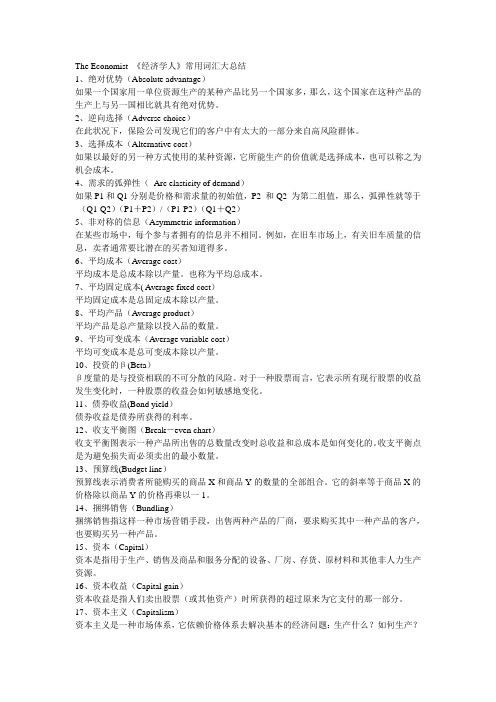
The Economist 《经济学人》常用词汇大总结1、绝对优势(Absolute advantage)如果一个国家用一单位资源生产的某种产品比另一个国家多,那么,这个国家在这种产品的生产上与另一国相比就具有绝对优势。
2、逆向选择(Adverse choice)在此状况下,保险公司发现它们的客户中有太大的一部分来自高风险群体。
3、选择成本(Alternative cost)如果以最好的另一种方式使用的某种资源,它所能生产的价值就是选择成本,也可以称之为机会成本。
4、需求的弧弹性(Arc elasticity of demand)如果P1和Q1分别是价格和需求量的初始值,P2 和Q2 为第二组值,那么,弧弹性就等于-(Q1-Q2)(P1+P2)/(P1-P2)(Q1+Q2)5、非对称的信息(Asymmetric information)在某些市场中,每个参与者拥有的信息并不相同。
例如,在旧车市场上,有关旧车质量的信息,卖者通常要比潜在的买者知道得多。
6、平均成本(Average cost)平均成本是总成本除以产量。
也称为平均总成本。
7、平均固定成本( Average fixed cost)平均固定成本是总固定成本除以产量。
8、平均产品(Average product)平均产品是总产量除以投入品的数量。
9、平均可变成本(Average variable cost)平均可变成本是总可变成本除以产量。
10、投资的β(Beta)β度量的是与投资相联的不可分散的风险。
对于一种股票而言,它表示所有现行股票的收益发生变化时,一种股票的收益会如何敏感地变化。
11、债券收益(Bond yield)债券收益是债券所获得的利率。
12、收支平衡图(Break-even chart)收支平衡图表示一种产品所出售的总数量改变时总收益和总成本是如何变化的。
收支平衡点是为避免损失而必须卖出的最小数量。
13、预算线(Budget line)预算线表示消费者所能购买的商品X和商品Y的数量的全部组合。
The_Economist_《经济学人》常用词汇总结[1]1
![The_Economist_《经济学人》常用词汇总结[1]1](https://img.taocdn.com/s3/m/ea5c610ebb68a98271fefaa0.png)
The Economist 《经济学人》常用词汇总结我眼泪都流出来了太珍贵了!!来源:石小磊的日志1、绝对优势(Absolute advantage)如果一个国家用一单位资源生产的某种产品比另一个国家多,那么,这个国家在这种产品的生产上与另一国相比就具有绝对优势。
2、逆向选择(Adverse choice)在此状况下,保险公司发现它们的客户中有太大的一部分来自高风险群体。
3、选择成本(Alternative cost)如果以最好的另一种方式使用的某种资源,它所能生产的价值就是选择成本,也可以称之为机会成本。
4、需求的弧弹性(Arc elasticity of demand)如果P1和Q1分别是价格和需求量的初始值,P2 和Q2 为第二组值,那么,弧弹性就等于-(Q1-Q2)(P1+P2)/(P1-P2)(Q1+Q2)5、非对称的信息(Asymmetric information)在某些市场中,每个参与者拥有的信息并不相同。
例如,在旧车市场上,有关旧车质量的信息,卖者通常要比潜在的买者知道得多。
6、平均成本(Average cost)平均成本是总成本除以产量。
也称为平均总成本。
7、平均固定成本( Average fixed cost)平均固定成本是总固定成本除以产量。
8、平均产品(Average product)平均产品是总产量除以投入品的数量。
9、平均可变成本(Average variable cost)平均可变成本是总可变成本除以产量。
10、投资的β(Beta)β度量的是与投资相联的不可分散的风险。
对于一种股票而言,它表示所有现行股票的收益发生变化时,一种股票的收益会如何敏感地变化。
11、债券收益(Bond yield)债券收益是债券所获得的利率。
12、收支平衡图(Break-even chart)收支平衡图表示一种产品所出售的总数量改变时总收益和总成本是如何变化的。
收支平衡点是为避免损失而必须卖出的最小数量。
The Economist 《经济学人》常用词汇总结
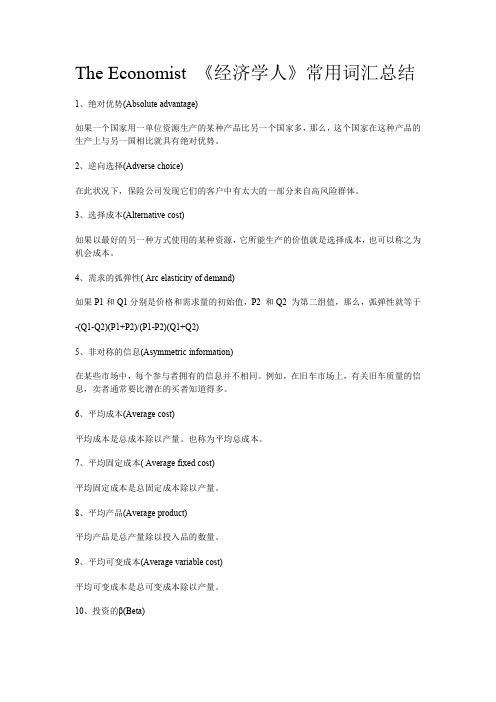
The Economist《经济学人》常用词汇总结1、绝对优势(Absolute advantage)如果一个国家用一单位资源生产的某种产品比另一个国家多,那么,这个国家在这种产品的生产上与另一国相比就具有绝对优势。
2、逆向选择(Adverse choice)在此状况下,保险公司发现它们的客户中有太大的一部分来自高风险群体。
3、选择成本(Alternative cost)如果以最好的另一种方式使用的某种资源,它所能生产的价值就是选择成本,也可以称之为机会成本。
4、需求的弧弹性(Arc elasticity of demand)如果P1和Q1分别是价格和需求量的初始值,P2和Q2为第二组值,那么,弧弹性就等于-(Q1-Q2)(P1+P2)/(P1-P2)(Q1+Q2)5、非对称的信息(Asymmetric information)在某些市场中,每个参与者拥有的信息并不相同。
例如,在旧车市场上,有关旧车质量的信息,卖者通常要比潜在的买者知道得多。
6、平均成本(Average cost)平均成本是总成本除以产量。
也称为平均总成本。
7、平均固定成本(Average fixed cost)平均固定成本是总固定成本除以产量。
8、平均产品(Average product)平均产品是总产量除以投入品的数量。
9、平均可变成本(Average variable cost)平均可变成本是总可变成本除以产量。
10、投资的β(Beta)β度量的是与投资相联的不可分散的风险。
对于一种股票而言,它表示所有现行股票的收益发生变化时,一种股票的收益会如何敏感地变化。
11、债券收益(Bond yield)债券收益是债券所获得的利率。
12、收支平衡图(Break-even chart)收支平衡图表示一种产品所出售的总数量改变时总收益和总成本是如何变化的。
收支平衡点是为避免损失而必须卖出的最小数量。
13、预算线(Budget line)预算线表示消费者所能购买的商品X和商品Y的数量的全部组合。
经济学人2011最新文章整理(中英文对照)
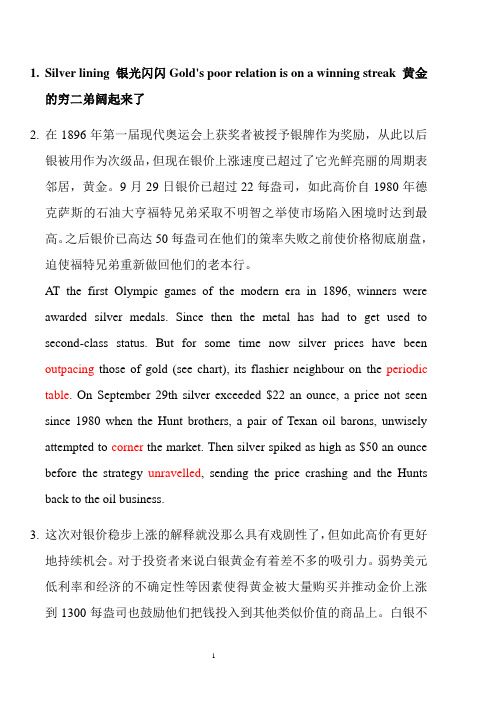
1.Silver lining 银光闪闪Gold's poor relation is on a winning streak 黄金的穷二弟阔起来了2.在1896年第一届现代奥运会上获奖者被授予银牌作为奖励,从此以后银被用作为次级品,但现在银价上涨速度已超过了它光鲜亮丽的周期表邻居,黄金。
9月29日银价已超过22每盎司,如此高价自1980年德克萨斯的石油大亨福特兄弟采取不明智之举使市场陷入困境时达到最高。
之后银价已高达50每盎司在他们的策率失败之前使价格彻底崩盘,迫使福特兄弟重新做回他们的老本行。
A T the first Olympic games of the modern era in 1896, winners wereawarded silver medals. Since then the metal has had to get used to second-class status. But for some time now silver prices have been outpacing those of gold (see chart), its flashier neighbour on the periodic table. On September 29th silver exceeded $22 an ounce, a price not seen since 1980 when the Hunt brothers, a pair of Texan oil barons, unwisely attempted to corner the market. Then silver spiked as high as $50 an ounce before the strategy unravelled, sending the price crashing and the Hunts back to the oil business.3.这次对银价稳步上涨的解释就没那么具有戏剧性了,但如此高价有更好地持续机会。
经济学人XXXX年11月份
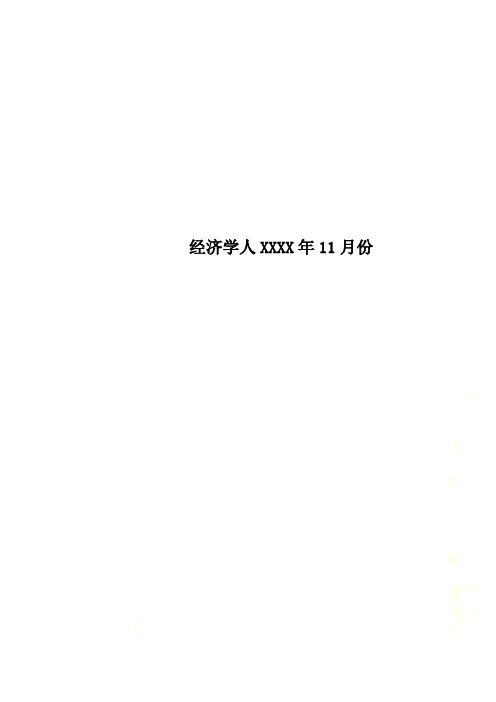
经济学人XXXX年11月份Science and technology科学技术Academic publishing学术出版Free-for-all自由竞争Open-access scientific publishing is gaining ground科学出版的开放存取已逐渐被人们所接受AT THE beginning of April, Research Councils UK, a conduit through which the government transmits taxpayers' money to academic researchers, changed the rules on how the results of studies it pays for are made public.四月初,英国研究理事会—一个由政府向学术研究者提供资金机构-改变了它的一项规则:即该机构提供资助的一些研究成果是否可以自由出版。
经济学人下载:学术出版自由竞争From now on they will have to be published in journals that make them available free—preferably immediately, but certainlywithin a year.从今后,这些成果将必须在期刊上自由,免费发表—最好是结果出来后立即出版,但是出版时间最迟不能超过一年。
In February the White House Office of Science and Technology Policy told federal agencies to make similar plans.今年二月,白宫科学和技术政策办公室也要求联邦机构做出与之相类似的计划。
A week before that, a bill which would require free access to government-financed research after six months had begun to wend its way through Congress.在此前一周,国会也通过了一项法案—即政府资助研究产生成果六个月后,可以自由出版,虽然投票通过的过程有些曲折。
- 1、下载文档前请自行甄别文档内容的完整性,平台不提供额外的编辑、内容补充、找答案等附加服务。
- 2、"仅部分预览"的文档,不可在线预览部分如存在完整性等问题,可反馈申请退款(可完整预览的文档不适用该条件!)。
- 3、如文档侵犯您的权益,请联系客服反馈,我们会尽快为您处理(人工客服工作时间:9:00-18:30)。
@红糖小饼干
See ya !
booze[buːz] n. 酒 Pennsylvania[,pensil'veinjə] n. 宾夕法尼亚州(美国州名) spare[speə(r)] v. 饶恕 cheesemonger['tʃiːzmʌŋgə] n. 干酪商,干酪店
@红糖小饼干
Dutch and Californian cannabis dispensaries were also allowed to reopen. Weed sales in California reportedly tripled as tokers pondered life cooped up with their families.
Belgium[ˈbeldʒəm] n. 比利时 association[əˌsəʊsiˈeɪʃn; əˌsəʊʃiˈeɪʃn] n. 协会,联盟 beseech[bɪˈsiːtʃ] vt. 恳求,哀求;乞求
@红糖小饼干
Dry cleaners and launderettes have usually remained open, including in New York. But the need to look dapper does not extend to coiffures. Barbers and hairdressers closed in much of Europe (though Germany let them stay open at first).
log[lɒɡ] n.日志;(定期或系统的)观察记录 liable[ˈlaɪəbl] adj. 有责任的,有义务的 premises[ˈpremɪsɪz] n. 前提;经营场址
@红糖小饼干
Non-food establishments from Lucknow to Los Angeles might anyway see few clients even if they kept going. People must juggle child care with remote work. They have lost their income, or are about to; confidence is plummeting. Until it rebounds, shopkeepers may prefer to seek government lifesupport. ■
vie [vaɪ] v. 争夺,激烈竞争 confinement[kənˈfaɪnmənt] n. 限制;监禁 spare from使某人免受不愿意之事 edict[ˈiːdɪkt] n. 法令;布告 pharmacy [ˈfɑːməsi] n. 药房 exemption[ɪɡˈzempʃn] n. 免除,豁免;免税
@Байду номын сангаас糖小饼干
the Economist
经济学人 2020年
@红糖小饼干
@红糖小饼干
Man does not live by bread alone, even in confinement. Sections of the world’s high streets have been spared from national edicts to shut up shop until covid-19 passes. Supermarkets, pharmacies and banks remain open just about everywhere. Other exemptions reflect which industries politicians feel voters cannot do without.
trim[trɪm] v. 修剪;;削减(开支费用等); handout[ˈhændaʊt] n.;上课老师发的印刷品;文字资料;施舍物
@红糖小饼干
South Korea at no point strictly enforced closure of commerce. But gyms and night clubs that want to stay open must keep a visitor log and enforce distancing rules or be held liable for medical bills of anyone infected on their premises.
launderette[ˌlɔːndəˈret] n. 自助洗衣店 dapper[ˈdæpə(r)] adj. 短小精悍的;衣冠楚楚的;整洁的 coiffure[kwɑːˈfjʊə(r)] vt. 把头发做成某种式样 Barber[ˈbɑːbə(r)] n.理发师;(男子)理发店
@红糖小饼干
Their trade group, too, pleaded for them to be forced to stay shut, pointing out that hairdressers could scarcely avoid coming into close contact with customers. Also, being closed can help trim expenses by putting staff on government wage-replacement schemes, and perhaps other handouts.
Dutch[dʌtʃ] adj. 荷兰的;荷兰人的;荷兰语的 cannabis[ˈkænəbɪs] n. 印度大麻 dispensary[dɪˈspensəri] n. 药房 triple[ˈtrɪpl] n. 三倍数;三个一组 ponder[ˈpɒndə(r)] vt. 仔细考虑;衡量 cooped up被禁锢的
@红糖小饼干
Is booze a basic need? Not in Pennsylvania or India, where alcohol retailers have been shuttered. France, predictably, has spared its wine merchants. Cavistes had originally been ordered to close, then permitted to stay open even as the French lockdown was tightened (cheesemongers count as food shops, in case you were wondering).
@红糖小饼干
Bookshops remain open in Belgium but not Britain, despite an appeal by James Daunt, boss of Waterstones, a big chain, that they were “no different to a supermarket or pharmacy”. By contrast, when France’s finance minister, Bruno Le Maire, wanted to exempt booksellers, their association beseeched him to keep them closed—but also to stop Amazon and supermarkets from selling books.
